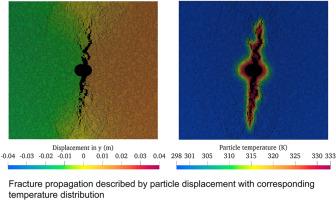CFD-DEM modeling of fluid-driven fracture induced by temperature-dependent polymer injection
IF 4.3
2区 材料科学
Q2 ENGINEERING, CHEMICAL
引用次数: 0
Abstract
This study numerically investigates fracture initiation and propagation during polymer-based solution injection under varying thermal conditions. A coupled computational fluid dynamics and discrete element method (CFD-DEM) framework is used to model non-Newtonian fluid flow through a granular medium. The rheology of shear-thinning fluids and fluid-particle heat transfer are modeled with temperature-dependent power-law parameters. The current model is validated by comparing fracture propagation behavior and peak pressures against the similar numerical study. The adequacy of the fluid-particle heat transfer model is confirmed by comparing the results with an analytical approach. The simulation results show that polymer concentration significantly influences fracturing behavior. Less concentrated, lower-viscosity fluids are more likely to create linear fracture paths with enhanced fluid infiltration. In contrast, fluids with higher polymer concentrations and viscosities tend to produce wider fractures characterized by greater particle displacement. An increase in the fluid temperature injected into the cooler medium leads to a reduction of fracture size for the 0.4 % (w/w) XG solution, while the 0.6 % (w/w) XG solution tends to form more linear fracture tips. At sufficiently elevated medium temperatures, the injection of cooler fluids prevents fracture initiation for both concentrations. Lower-viscosity cases, dominated by infiltration, reflect broader thermal transitions in particle temperature distribution, whereas higher-viscosity cases, characterized by particle displacement, exhibit narrower transition regions along fracture boundaries. A fracture initiation criterion for shear-thinning fluids is proposed based on the dimensionless parameters Π1 and τ2. Fracture occurs when Π1 > 73 and τ2 > 3.58 × 10−9. The 0.4 % solution exhibits lower thermal sensitivity with relatively minimal variations in the dimensionless parameters, while the 0.6 % solution shows a greater response to temperature changes, reflected in broader variations of these parameters.

温度相关聚合物注入流体驱动裂缝的CFD-DEM建模
本文对不同热条件下聚合物基溶液注入过程中的裂缝萌生和扩展进行了数值研究。采用计算流体力学和离散元法(CFD-DEM)的耦合框架对非牛顿流体在颗粒介质中的流动进行了建模。剪切减薄流体的流变学和流体-颗粒传热用温度相关的幂律参数建模。通过将裂缝扩展行为和峰值压力与类似数值研究进行比较,验证了当前模型的有效性。通过与解析方法的比较,证实了流体-颗粒传热模型的充分性。模拟结果表明,聚合物浓度对压裂行为有显著影响。浓度较低、粘度较低的流体更有可能形成线性裂缝路径,并增强流体的渗透性。相反,聚合物浓度和粘度较高的流体往往会产生更宽的裂缝,其特征是颗粒位移更大。注入较冷介质的流体温度升高导致0.4% (w/w) XG溶液的裂缝尺寸减小,而0.6% (w/w) XG溶液倾向于形成更线性的裂缝尖端。在足够高的介质温度下,注入较冷的流体可以防止两种浓度的裂缝发生。以渗透为主的低粘度情况下,颗粒温度分布的热转变范围更广,而以颗粒位移为特征的高粘度情况下,沿裂缝边界的热转变区域更窄。提出了基于无因次参数Π1和τ2的剪切变稀流体起裂判据。断裂发生在Π1 >; 73和τ2 >; 3.58 × 10−9。0.4%溶液表现出较低的热敏性,无量纲参数的变化相对较小,而0.6%溶液对温度变化的响应较大,反映在这些参数的变化范围较大。
本文章由计算机程序翻译,如有差异,请以英文原文为准。
求助全文
约1分钟内获得全文
求助全文
来源期刊

Particuology
工程技术-材料科学:综合
CiteScore
6.70
自引率
2.90%
发文量
1730
审稿时长
32 days
期刊介绍:
The word ‘particuology’ was coined to parallel the discipline for the science and technology of particles.
Particuology is an interdisciplinary journal that publishes frontier research articles and critical reviews on the discovery, formulation and engineering of particulate materials, processes and systems. It especially welcomes contributions utilising advanced theoretical, modelling and measurement methods to enable the discovery and creation of new particulate materials, and the manufacturing of functional particulate-based products, such as sensors.
Papers are handled by Thematic Editors who oversee contributions from specific subject fields. These fields are classified into: Particle Synthesis and Modification; Particle Characterization and Measurement; Granular Systems and Bulk Solids Technology; Fluidization and Particle-Fluid Systems; Aerosols; and Applications of Particle Technology.
Key topics concerning the creation and processing of particulates include:
-Modelling and simulation of particle formation, collective behaviour of particles and systems for particle production over a broad spectrum of length scales
-Mining of experimental data for particle synthesis and surface properties to facilitate the creation of new materials and processes
-Particle design and preparation including controlled response and sensing functionalities in formation, delivery systems and biological systems, etc.
-Experimental and computational methods for visualization and analysis of particulate system.
These topics are broadly relevant to the production of materials, pharmaceuticals and food, and to the conversion of energy resources to fuels and protection of the environment.
 求助内容:
求助内容: 应助结果提醒方式:
应助结果提醒方式:


